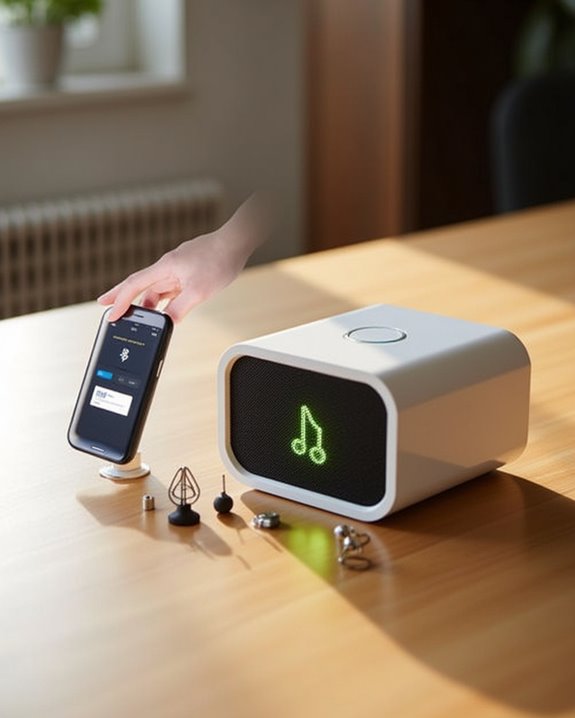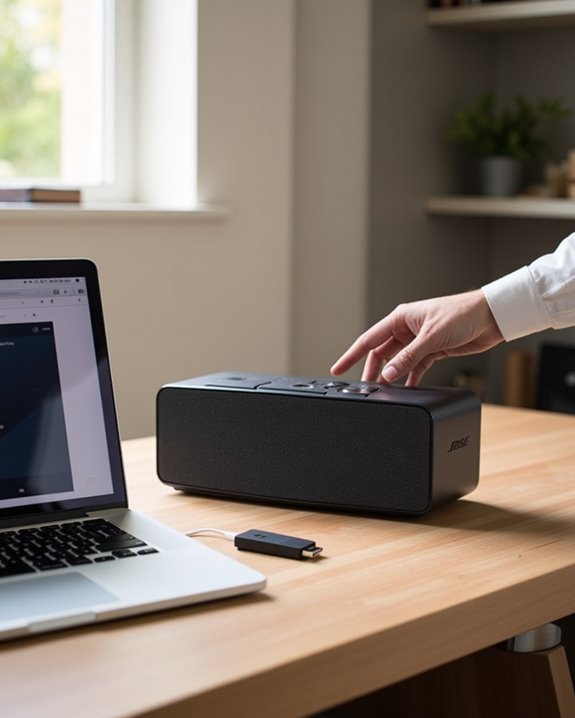Charging a Philips Bluetooth speaker requires a compatible 5V, 0.5A USB power adapter and original USB cable to guarantee efficient energy transfer and device longevity. Align the USB plug accurately with metal pins to prevent connection interruption. Charging status is indicated by LED signals—blinking when off and a single beep when on—lasting approximately 4.5 hours for a full cycle. Using improper voltage or faulty chargers risks battery damage. Understanding these fundamentals promotes ideal battery performance. Additional insights on troubleshooting and maintenance follow.
Key Takeaways
- Use the included USB cable and a 5V, 0.5A power adapter to connect the Philips speaker to a power source for charging.
- Ensure the USB plug is correctly aligned with the charging jack to avoid interruptions in power delivery.
- When the speaker is off, a blinking LED indicates active charging; a single beep signals charging if the speaker is on.
- Charge the speaker for at least 4.5 hours initially to fully restore the battery.
- Disconnect the charger once the LED indicator stops blinking, signaling the battery is fully charged.
Required Charging Accessories for Philips Bluetooth Speaker
A critical component for charging the Philips Bluetooth Speaker effectively is the use of the specified 5V, 0.5A power adapter, which aligns with the device’s voltage and current requirements to guarantee ideal battery replenishment and prevent electrical strain. The speaker includes a USB cable that must be paired with this power adaptor to guarantee compatibility and ideal charging efficiency. The USB plug features metal pins that require correct alignment with the charging jack to establish a stable connection; improper fitting can obstruct power transfer. Users should note the light on the speaker, which indicates the charging status when the Power Button is engaged. Utilizing the original supplied accessories preserves device longevity and charging reliability, affirming their essential role in maintaining the Bluetooth speaker’s performance and user satisfaction.
Correct Charging Procedure and Indications
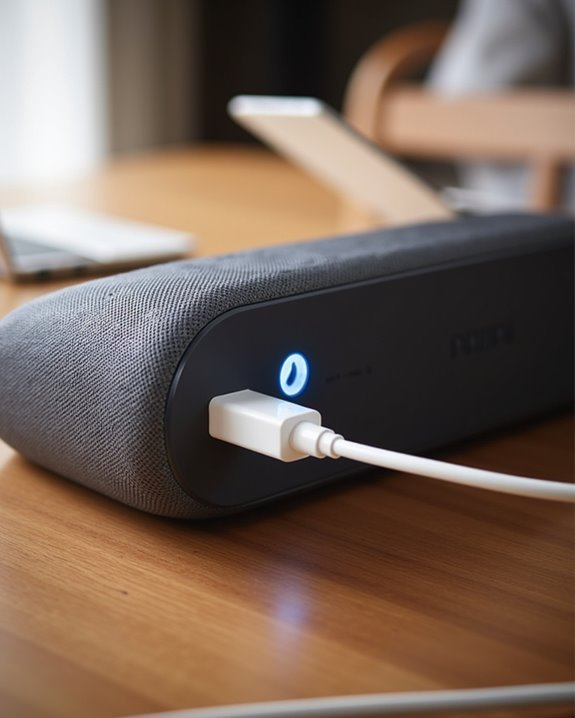
Ensuring proper charging of the Philips Bluetooth Speaker requires adherence to specific procedural steps and attention to the device’s indicator signals. To charge your device effectively, use a recommended 5V, 0.5A power adaptor, ensuring the USB plug’s metal pins align correctly with the jack side to prevent charging interruptions. When the speaker is off, a blinking LED indicates active charging; if powered on, a single beep confirms charging initiation without LED signals. For fully depleted batteries, charging indications may take long periods to manifest, necessitating patience. To verify battery status during charging, press and hold the on/off button briefly for a quick update. The speaker signals when fully charged by ceasing LED activity or beeping, enabling users to manage charging cycles effectively and prolong battery longevity in devices Bluetooth.
Troubleshooting Charging Issues
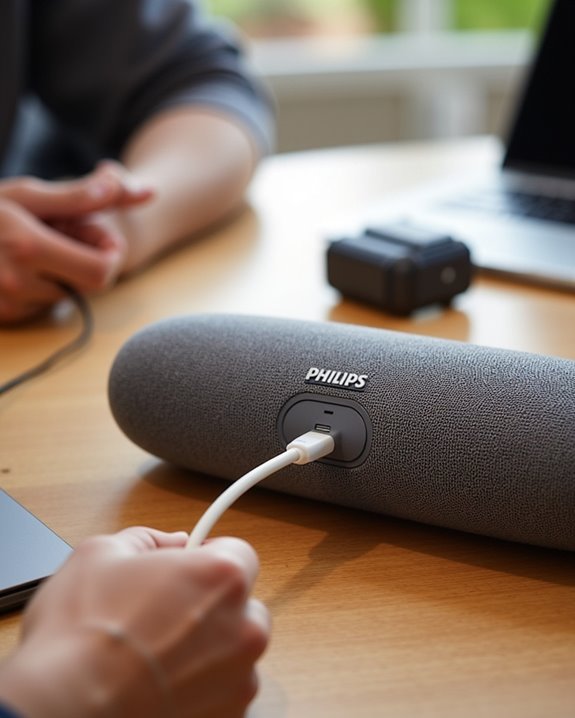
Charging indicators on the Philips Bluetooth speaker provide visual feedback through LED signals, which clarify the device’s current charging status and battery health. Common charging problems often stem from improper USB connections, inadequate power supply—specifically, chargers not delivering the required 5 volts at 2 amps—or depleted batteries requiring replacement. Understanding these indicators and typical issues facilitates accurate diagnosis and effective resolution, ensuring ideal speaker performance. Additionally, ensuring your charger and cables meet the recommended specifications can significantly improve charging efficiency.
Charging Indicators Explained
Understanding the LED and auditory feedback mechanisms of the Philips Bluetooth speaker provides critical insight into its charging status and troubleshooting procedures. When the speaker is off, a blinking LED signals active charging, enabling users to make sure the device is properly powered. If powered on during charging, the speaker emits a single beep without LED indication, which may confuse users unfamiliar with this subject. A fully depleted battery can delay these indicators for hours, requiring patience. To verify charging status, briefly pressing the on/off button reveals battery level regardless of power state. Users should note that LED charging signals function only when the speaker is off. For those who buy this device and engage in Bluetooth pairing, understanding these affiliated charging cues guarantees effective usage and maintenance.
Common Charging Problems
What factors contribute to common charging issues in Philips Bluetooth speakers can often be traced to connection integrity, power source compatibility, and battery condition. A secure USB connection is essential; an improper fit can interrupt power delivery. Using a faulty charger, tested by compatibility with other devices, often resolves charging issues caused by inadequate current supply. The power adapter must provide a stable output of 5 volts and 2 amps to achieve best charging performance. Initial charging should last at least 4.5 hours, especially if battery depletion is severe, to prevent inaccurate charge indicators. Persistent problems may indicate a defective battery, warranting inspection and possible replacement as detailed in the battery change guide. Addressing these technical aspects improves charging reliability and speaker longevity.
Battery Care and Maintenance Tips
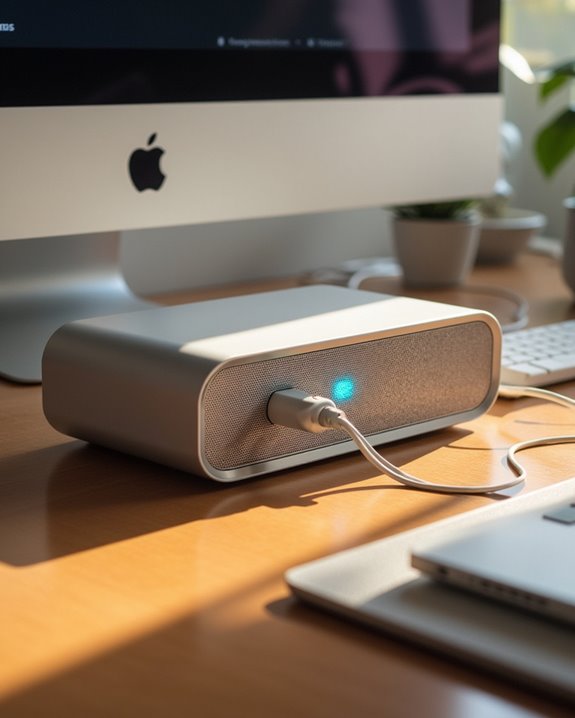
Proper battery care for the Philips Bluetooth speaker involves using a 5V, 0.5A adaptor to guarantee stable voltage and current during charging, which helps maintain battery efficiency and lifespan. Monitoring the battery level regularly via the on/off button prevents deep discharge, thereby preserving capacity over time. Additionally, aligning the USB plug correctly and charging the device for at least 4.5 hours supports ideal battery performance and prevents premature degradation.
Charging Best Practices
A 5V, 0.5A power adaptor is the recommended charging source for the Philips Bluetooth speaker, as it guarantees ideal battery health by preventing overcurrent stress and potential thermal damage. Proper alignment of the USB plug’s metal pins with the charging jack secures a stable connection, reducing risks of interruption during charging. Users should check the battery level by briefly pressing the on/off button, enabling monitoring without fully activating the speaker. When powered off, a blinking LED indicator confirms active charging, signaling that the battery is receiving power and helping to avoid overcharging. Charging the speaker for a minimum of 4.5 hours when the battery is low fully replenishes the battery, supporting consistent performance and preserving battery health over time.
Battery Longevity Tips
Maintaining the longevity of the Philips Bluetooth speaker’s battery involves adherence to specific charging protocols that optimize electrochemical stability and minimize capacity degradation. To preserve battery health, users should employ a 5V, 0.5A adaptor, delivering consistent power without inducing strain. Charging the speaker to a full charge—100%, indicated by four blinking white lights—prevents partial charge cycles that accelerate wear. Avoid depletion by recharging before the battery fully discharges; a completely drained battery may delay charging response and reduce lifespan. Recommended charging duration is at least 4.5 hours when battery levels are low, ensuring complete recharge and mitigating over-discharge risks. Regular battery level checks via the on/off button facilitate timely recharging, sustaining overall battery longevity. These charging tips collectively enhance battery performance and extend operational life.
Ensuring Proper Power Adapter and Cable Usage
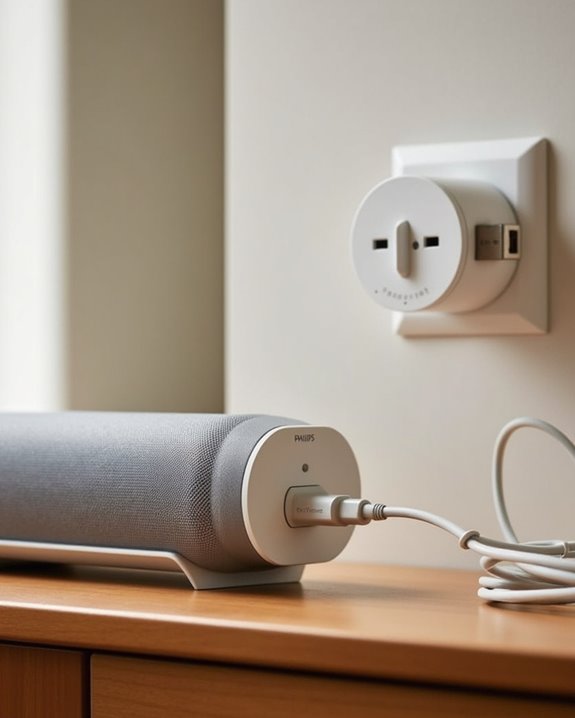
When selecting a power adapter and cable for charging the Philips Bluetooth speaker, adherence to the specified electrical requirements is critical; the recommended adapter supplies 5 volts at 0.5 amperes, which guarantees stable current flow and prevents potential overvoltage damage. Utilizing the supplied USB cable and power adapter guarantees compatibility with the device’s charging circuit, optimizing 5V charging efficiency. Avoid using a 5A adapter, as its higher amperage exceeds the device’s design limits and may cause instability. Proper insertion of the USB cable, aligning metal pins with the jack, is essential to avoid connection failures. Additionally, verifying the power adapter’s specifications and guaranteeing the charger cord fits securely prevents ineffective charging, maintaining device integrity and reliable power delivery during each charging cycle. For enhanced performance, using rechargeable batteries compatible with similar electronics can provide extended usability and cost savings over time.
Support and Contact Information for Philips Users
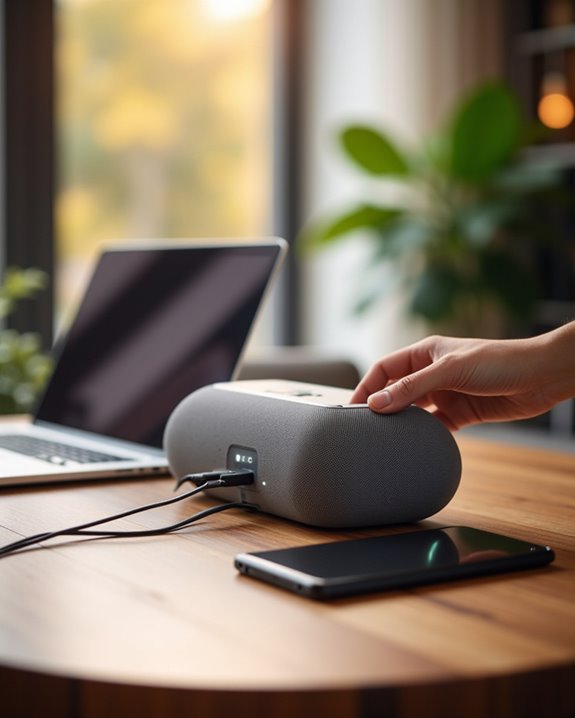
For users experiencing difficulties with charging their Philips Bluetooth speaker, direct access to Philips customer support provides valuable technical assistance, ensuring issues are addressed efficiently. Philips Support offers thorough troubleshooting resources on its homepage, including detailed guides for charging issues specific to Bluetooth speakers. The prominently displayed Contact Us option facilitates quick communication with technical experts who provide personalized solutions. Additionally, the Online Store Support section extends assistance by offering product-specific charging accessories and compatibility information. Philips’ support infrastructure enhances user experience by systematically resolving common charging problems, thereby maintaining ideal device performance. Users seeking precise, authoritative help benefit from this structured support network, which empowers them to address power-related challenges effectively and prolong their Bluetooth speaker’s operational lifespan.
Frequently Asked Questions
How Do You Charge a Philips Speaker?
Charging a Philips speaker requires connecting the charging cable to its USB port and a compatible power adapter. Battery life improves with proper charging time, ensuring the device reaches full capacity for extended use and shared enjoyment.
How Do I Know if My Philips Speaker Is Charging?
When in Rome, do as the Romans do: visual cues like blinking status lights and battery icons signal charging when off, while audio signals such as a single beep serve as charge alerts when the Philips speaker powers on.
How Do I Charge My Bluetooth Speaker?
To charge the Bluetooth speaker, connect the USB cable to the charging port and a reliable power source. While fast charging and wireless options may vary, maintaining battery life guarantees consistent use and belonging within a connected community.
How Do I Know if My Speaker Is Charging?
When does silence speak louder than words? A Philips speaker’s charging sound or LED color signal battery indicator activity, while app notifications and voltage checks provide reassuring proof, uniting users in shared energy and connectivity.


